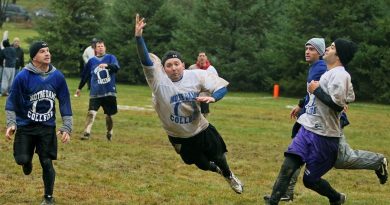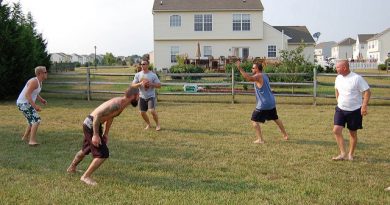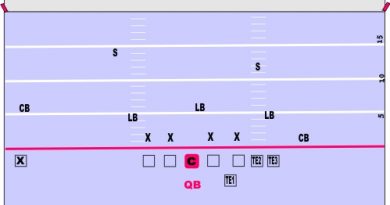The Glorious Running Back
Every young boy grows up aspiring to play football someday. Either in the little leagues, junior high, high school, college, and eventually, in the NFL. Most parents begin this indoctrination from a very young age. Every father dreams of one day watching his son play this great game. Fathers typically encourage their children to either play quarterback, wide receiver, or running back. In school yards and at playgrounds, it is the quarterback, wide out, and tail back that are on the receiving end of their playmates respect and praise.
And it is this last position that we will discuss today! In all its glory!
Running back is a unique position. It takes talent, speed, and heart. If any of these attributes is missing, the player will most likely fail and end up playing some other position.
What is a running back? What do they do? How should they play? What are some tips for aspiring running backs.
What does the running back do?
The running back is the player that runs with the ball. Unlike the full back, the running back does more running than blocking. In high school athletics, running backs are the core of the game. Most plays are designed for running backs, as it is difficult to throw. However, in the playgrounds, the wide receivers dominate. But not consistently enough to be featured in high school offensive attacks.
The running back can either receive the ball directly (hand off) or indirectly (pitch). The hand off requires coordination between the quarterback and running back and is the bread and butter of a running game. The pitch, which is a short toss, is a little more difficult to execute, and more can go wrong. The biggest mistakes are made in the exchange between the QB and running back. The QB may hand the ball off wrong, or pitch it in a weird way. Make sure you know what each one is.
Who is the running back?
The running back must have extremely acute peripheral vision and be able to see the whole field. The running back knows how people will react to his every move and every movement of his eyes. The running back must know when to make cuts, and whether or not one is needed. The running back must have speed and must be able to outrun the majority (or all) of the other players. The running back must have heart. Many running backs will not put their head down and take a hit, they’d rather run out of bounds or take a push or bump. One must be able to put their head down and push for the extra yards. Some players take this to the extreme. Some guys run with their head down too far. Some run in a very upright position. A delicate balance must be achieved.
Some running Do’s and Don’ts
Don’t ever run the play in reverse on your own. If in the huddle everyone agrees to run left, run left. Changing a play according to your own whim, without notifying the other players on your team, can really mess things up. Either you will get hurt, or the play will not work. We all known someone who does that in backyard football. Everyone will think he is running right, then all of a sudden he runs left, due to fear of tacklers.
Don’t run sideways. A running back must gain yards. You are already starting behind the line of scrimmage, do not run sideways. Some people feel that they can outsmart, or juke, the other players. More often than not, you will get tackled for a loss. Running sideways attempting to sidestep other players should be done way after passing the line of scrimmage, not everyone is Barry Sanders.
Be consistent. Some players try the position out. They have a good play or two, and then loose their touch. Think about what went wrong. Think about why you lost your touch. Be as consistent as possible. The running back is the go-to guy. The quarterback must depend on you as a last resort, in most cases. Make sure you are as consistent as possible. Some players, will run one play for a 5 yard gain, and then lose a few yards. And then lose some more, then break one, then lose more, then fumble, then throw the ball up. When this happens, you must relegate yourself to simply blocking. No one is perfectly consistent, but when you know you are having problems, step aside. You have to be a consistent runner for years, this produces dependability. Few players are dependable runners, but when you find one, it’s golden.
Do not attempt to play running back based on size and weight alone. Some guys are very heavy and are relatively larger than the rest and hence attempt to play running back. This is very detrimental to your health. We’ve seen very large humans try to play at every level, they have all failed. Surely, a larger player may break out once in a while and do well, but over the long run you can not do this consistently. Either the player will get tired and ruin the teams progress by fumbling or losing yards, or he will get injured and retire early.
Running Tips
When you get the ball the first thing on your mind should be tucking the ball away safely. Put your fingertips over the cone end of the ball and tuck it away. The second thing on your mind should be getting past the line of scrimmage. The final thing on your mind while running is to keep the ball in your hands.
Cut back when it is effective. A lot of players make improper cutbacks and end their run too short. Only cut back if it will give you a distinct advantage. This is hard to describe, you simply need experience to know when to use the cutback. If you are not experienced, just run straight. Cutbacks are especially effective when they will cause the approaching player to either fall, turn around, lose speed, or become disoriented. We have all seen Terrell Davis run. Or those great wide receivers that cut back properly. It takes years to learn these techniques. A lot of it is instinct and you can’t really teach it. Have fun and try it out. It takes an intrinsic savvy or feel for the sport. You just know how the play will develop, then you know when it is good to cut back. A lot of non-running back players will complain and tell you to cutback or zigzag, just ignore them, they don’t know how the running game works. If you are producing consistent yardage, ignore the ignorant.
Spin only when the spin will either deflect an oncoming player or will keep you in bounds. Sometimes a spin is very effective. The spin must be quick and poignant. If you take too long you will be uprooted from your base, and that can be painful. Sometimes a spin will keep you in bounds or give you extra yards. Practice the spin and see where it can take you. I recall a play during my senior year when our full back ran a crosstrap and ran into our line, he spun around took off a few yards to the side, turned it up, and ran it in from the two-yard line. That was one of the greatest spins ever witnessed. We have all seen great spins. Quarterbacks use the spin to eliminate pursuant line men, and running backs use it quite often to eliminate would be tacklers. A spin can also lessen a blow. But, use it sparingly.
Put your head down. While running down the field, rather than letting a defender take you down, put your head down and keep going. It is very hard to tackle someone whose head is in a downward position. Just ask Emmitt Smith, Eddie George, or Adrian Peterson. If you are being brought down and there is a defender in front of you, put your head down into his gut and push. Heads are very hard, guts are very soft. Usually the blow will knock the wind out of the player and make your run easier.
Never stop moving your feet. Always push and kick your feet. Also you can run with your knees high up, that scares would-be tacklers from trying to take your legs out, and forces them to hit you high. Even if people are hanging on you or holding you, keep pushing with your legs. This is a very helpful technique. Keep those legs pumping. Eventually you will go down, but not without giving some defenders a free ride.
Make sure you don’t run in an upright position. That is very bad form. Sometimes people will try putting a wide receiver in for a running play, wide outs always run with their head up and body upright. This will hurt when hit or tackled. Always run in a forward leaning and semi downward position.
Last but not least, learn to block. You will definitely need to block. Especially the way we play soft backyard and high school football these days. At some point you will have to block. Learn the form and don’t let anyone get to your quarterback. And if you are a wide receiver, learn to block so your running back will get more yardage on each run. Downfield blocking results in amazing plays! The smallest player can stop the biggest with proper form. And lastly, don’t be caught on tape with some one blowing by you and you just falling to the ground.
Note: This article was originally published in 1993 and was re-discovered recently in our archives. We have edited it for grammar and added more current examples of football players in some of the paragraphs. Funny how somethings never change!



